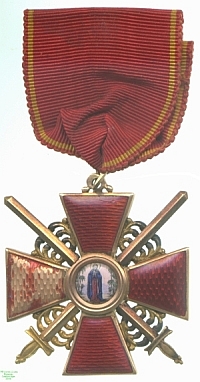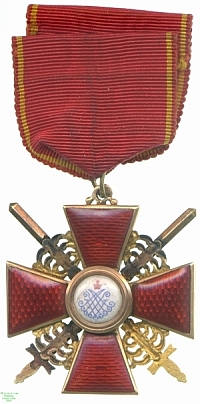Badge of the Order of St Anne, 2nd Class, awarded to 2nd Lt. John Mitchell 1919

Obverse, a painted icon of St Anne at the centre, done in enamels with a gold border, on crossed swords with floriate sprays sprouting from the blades on both sides of a Maltese Cross enamelled in red
|

Reverse, a figurative painted design in blue surmounted by a red crown on white enamel, in a gold border, on a Maltese Cross with arms enamelled in red
|
<- Previous | Next ->
Back to gallery page
Badge of the Order of St Anne, 2nd Class, 1919
The Order of St Anne was founded at Kiel by Duke Karl Friedrich of Holstein-Gottorp, son-in-law of the Russian Emperor Peter the Great and an exile at his court at the time. In 1796 the Order was incorporated with the Russian military orders.
During the collapse of Tsarist Russia in the Revolution of 1917, a Provisional Government was briefly formed to represent the interests of government against the Bolshevik factions of the new order, and then various regional governments were formed in their wake, but what came to be classed as White Russian (as opposed to Red) resistance was eventually (by the end of 1918) crystallised around the Siberian Regional Government led by the Vice-Admiral Aleksandr Kolchak.
Despite the death of not only Tsar Nicholas II in 1917 but Grand Duke Michael his notional successor in 1918, effectively ending the Romanov royal line in whose name they were given, Kolchak's government maintained the issue of royal decorations and orders until the final collapse of the White Russian resistance in 1921, by which time Kolchak, perhaps their most capable military leader, had been made to resign.
This Badge is not named, but we know from its provenance that it was awarded to 2nd Lieutenant John Mitchell, of the Royal Air Force contingent that served in South Russia in support of British forces embroiled in the unsuccessful defence of White Russia, with whose other medals Lester Watson acquired it. Mitchell's endeavours in this theatre won him decorations both for military gallantry and life-saving actions from each of Britain and the White Russians.
Although the catalogue of the Watson Collection considers Mitchell's awards as its Group 7, the medals of that group are not physically attached and so have been treated separately here. Nonetheless it was as a group that Lester Watson purchased them, from the London dealers Baldwin in 1928.

